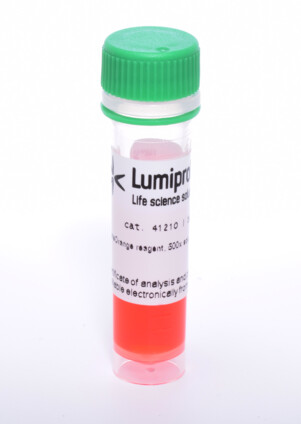ProteOrange® Protein Gel Stain, 5000×
| 目录号 | 数量 | 价格 | 提前通知时间 | 购买此产品 |
|---|---|---|---|---|
| 10210 | 100 uL |
–
|
现货 | |
| 40210 | 1 mL |
$285
|
现货 |

ProteOrange® is a protein-binding dye for staining protein gels, an analog of SYPRO Orange. The fluorophore is a styrene-like zwitterionic dye. It binds proteins selectively in the presence of nucleic acids, polysaccharides, and other molecules. It is also tolerant to SDS and, therefore, can be used for SDS-PAGE gel staining. The dye interacts with the SDS coat around proteins in the gel, giving more consistent staining between different types of proteins than CBB staining and never exhibiting negative staining. It also stains glycoproteins well.
Staining with ProteOrange is about an order of magnitude more sensitive than Coumassie dye staining and allows the detection of about 3 ng of protein per band (30 ng is the detection limit for Coumassie).
ProteOrange is supplied as a 5000x solution in DMSO. 1 mL of the solution is enough to staining around 200 minigels.

顾客还购买了这个产品
General properties
| Appearance: | orange solution |
| Storage conditions: | Storage: 24 months after receival at -20°C in the dark. Transportation: at room temperature for up to 3 weeks. Avoid prolonged exposure to light. Desiccate. |
| 安全数据表(MSDS): | 下载 |
| 产品规格 |
Spectral properties
| Excitation/absorption maximum, nm: | 470 |
| Emission maximum, nm: | 570 |
产品引用
- Sedlov, I. A.; Sluchanko, N. N. Biochemical Characterization of Selaginella 14-3-3 Protein Isoforms Provides Insights into the Evolution of Their Phylogenetic Groups. Plant Physiology and Biochemistry, 2025, 227, 110197. doi: 10.1016/j.plaphy.2025.110197
- Heesink, G.; van den Oetelaar, M.C.M.; Semerdzhiev, S.A.; Ottmann, C.; Brunsveld, L.; Blum, C.; Claessens, M.M.A.E. 14-3-3τ as a Modulator of Early α-Synuclein Multimerization and Amyloid Formation. ACS Chemical Neuroscience, 2024, 15(9), 1926-1936. doi: 10.1021/acschemneuro.4c00100
- Kuznetsova, A. A.; Soloveva, M. A.; Mikushina, E. S.; Gavrilova, A. A.; Bakman, A. S.; Kuznetsov, N. A. Characterization and PCR Application of Family B DNA Polymerases from Thermococcus Stetteri. Life, 2024, 14(12), 1544. doi: 10.3390/life14121544
- Somsen, B. A.; Sijbesma, E.; Leysen, S.; Honzejkova, K.; Visser, E. J.; Cossar, P. J.; Obšil, T.; Brunsveld, L.; Ottmann, C. Molecular Basis and Dual Ligand Regulation of Tetrameric Estrogen Receptor α/14-3-3ζ Protein Complex. Journal of Biological Chemistry, 2023, 299(7), 104855. doi: 10.1016/j.jbc.2023.104855























 $
$ 
